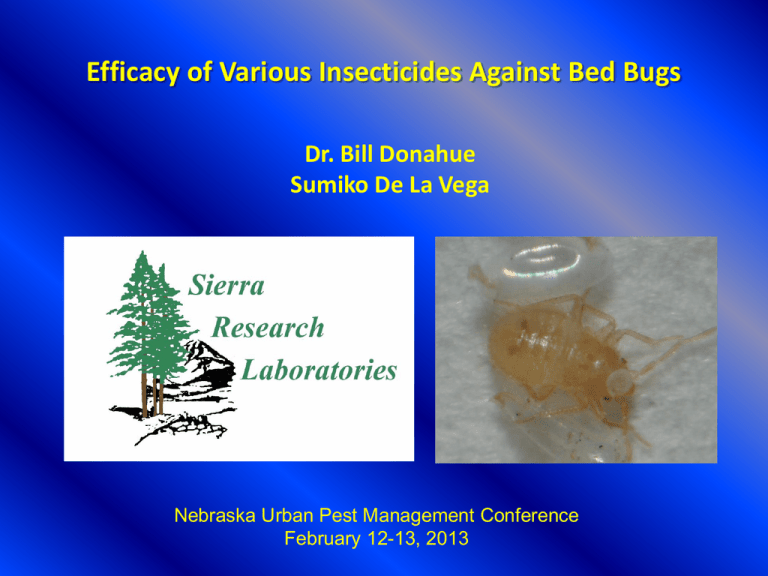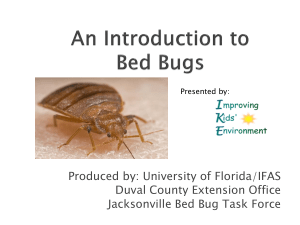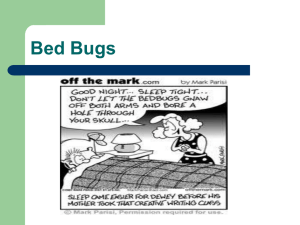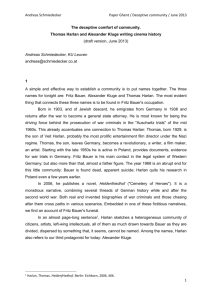
Efficacy of Various Insecticides Against Bed Bugs
Dr. Bill Donahue
Sumiko De La Vega
Nebraska Urban Pest Management Conference
February 12-13, 2013
“Brood Centers”
• Bed bugs are thigmotactic preferring rough
surfaces such as wood or paper.
• Cluster together in contact with each other
where fecal matter, egg shells and exuvia
accumulate - Semiochemicals
• Return to these harborages after a blood
meal.
• Quiescent state while digestion takes place.
• Stimulus to leave harborage? Hunger?
“Brood Centers”
Repellent
A chemical that makes unattractive to
arthropods a habitat, food source, or
oviposition site ordinarily sought and
frequented.
“Push-Pull” Theory – Repel and Attract - used
in the same environment
Objective
To evaluate the contact activity (mortality,
repellency, egg distribution and hatch) of
selected strains of bed bugs exposed to
treated fabric substrates.
Chemicals Evaluated
•
•
•
•
•
Permethrin Impregnated Fabrics (3) – 0.52% a.i.
Phantom Aerosol – Chlorfenapyr 0.5%
Alpine Aerosol – Dinotefuran 0.5%
Bedlam Aerosol – Sumithrin 0.4%, MGK-264 1.6%
Bed Bug Gel - Lactic Acid 20%, Rosemary Oil 1%,
Hops Flower Essential Oil 1%
Bed Bug Strains
• “Harlan” – Laboratory Susceptible Strain (Ft. Dix, NJ
1973 - SRL 2008) Adults Mixed Sex Ratio
• “Earl” – SRL Field Collected (Modesto, CA - 2007)
Susceptible Strain – Adults Mixed Sex Ratio
• “James” – SRL Field Collected (Modesto, CA - 2009)
Strain, 7X Permethrin Resistant – Adults Mixed Sex
Ratio
Test System
* Forced Exposure non-choice test
Permethrin Fabric
“Choice Test”
Aerosol “Choice Test”
Average percent mortality of adult bed bugs (2 Strains)
confined to three types of permethrin treated fabrics (“NonChoice”) compared with an untreated control as a continuous
forced exposure lethal time (LT) evaluation
Fabric
Type
1 hr
Harlan
1 hr
James
2 hr
Harlan
2 hr
James
4 hr
Harlan
4 hr
James
24 hr
Harlan
24 hr
James
#1
Beige
UPH
4
0
26
12
58
24
100
54
#2
Black
Stitch
16
0
22
6
64
18
100
50
#3
Knit
Ticking
44
10
56
48
94
66
100
78
#4
UTC
Woven
0
0
0
0
0
0
0
0
Average percent mortality of adult bed bugs (Harlan) confined
to three types of permethrin treated fabrics (“Choice Test”)
compared with an untreated control as a continuous exposure
lethal time (LT) evaluation
Fabric
Type
4 hr
24 hr
48 hr
72 hr
96 hr
#1 Beige
UPH
14
64
72
76
76
#2 Black
Stitch
26
46
64
72
78
#3 Knit
Ticking
30
52
60
66
68
#4 UTC
Woven
0
0
0
0
0
Total # of Eggs, average percent hatch and average percent
nymph mortality of bed bugs (Harlan) confined to three types
of permethrin treated fabrics (“Choice Test”) compared with
an untreated control as a continuous exposure evaluation
Treated Side
Total # Eggs
Untreated Side
Total # Eggs
Avg.% Hatch
Avg. % Nymph
Mortality
#1 Beige
UPH
3
73
83.5
19.7
#2
Black Stitch
6
90
86.6
34.4
#3
Knit Ticking
2
124
69.8
19.8
#4 UTC
Woven
124
189
87.0
2.6
Fabric Type
Mortality, distribution, average percent hatch and average
percent nymph mortality of bed bugs (Harlan) confined to
treated mattress ticking (“Choice Test”) compared with an
untreated control as a continuous exposure evaluation
Treatment
Max. Adult
% Mort
96 hr
% Adults Untreated Side
Avg % Distribution Eggs
4 hr
96 hr
Treated
Untreated
Avg %
Hatch
Avg %
Nymph
Mortality
Chlorfenapyr
Aerosol
0
96
82
13
87
96.6
78.0
Dinotefuran
Aerosol
0
58
74
31
69
98.0
0.6
Sumithrin
Aerosol
42
68
64
1
99
97.1
41.7
Lactic Acid +
Essential Oils
0
96
100
0
100
100
0.6
Conclusions
• Reliable and predictive small scale bioassay
• Sensitive – bed bug strains, chemicals (actives &
formulations)
• Demonstrates repellency – adults/nymphs,
oviposition sites – “Push-Pull” applications, but need
to understand the dynamics when including the host
and harborage in human habitats
• Evaluate control options based on unique bed bug
behavior – “Brood Centers” - Urban IPM
Questions?







